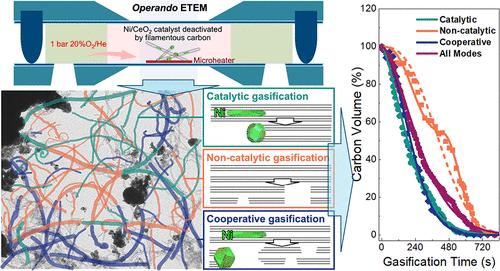废Ni/CeO2催化剂上丝状碳气化动力学和机理的操作解析
IF 13.1
1区 化学
Q1 CHEMISTRY, PHYSICAL
引用次数: 0
摘要
在许多重要的烃转化技术中,结焦是导致催化剂失活的主要原因。了解再生机制对于制定有效的除碳策略至关重要,从而提高催化剂的使用寿命,降低运营成本。在这里,我们使用原位环境透射电子显微镜(ETEM)结合语义分割技术,对工业相关的类空气条件下废Ni/CeO2催化剂的再生进行了空间分辨操作研究。通过对丝状碳去除的竞争气化事件进行反旋分析,我们发现了三种不同的气化模式──虽然快速催化气化是预期的,但不太稳定的非催化燃烧和协同气化也存在,甚至更为普遍。微观结构动力学直接将最大气化速率与通过Ni/碳接触或长丝断裂的轴向长丝消耗联系起来,强调了在所有气化途径中边缘平面碳位点的关键作用。此外,我们的operando表征揭示了Ni(−Cx)限制的碳扩散机制,这挑战了催化气化通常假设的传统碳体扩散模型。此外,还发现了Ni/碳接触破坏和气化诱导催化剂烧结等不利过程。总的来说,这些发现为碳气化过程提供了机制见解,突出了关键途径和潜在缺陷,可以指导催化剂再生策略的优化。本文章由计算机程序翻译,如有差异,请以英文原文为准。

Operando Elucidation of Filamentous Carbon Gasification Kinetics and Mechanisms on a Spent Ni/CeO2 Catalyst
Coking is the leading cause of catalyst deactivation in many important hydrocarbon conversion technologies. Understanding regeneration mechanisms is critical for developing effective carbon removal strategies that improve catalyst longevity and reduce operational costs. Here, we present a spatially resolved operando investigation of the regeneration of a spent Ni/CeO2 catalyst under industrially relevant air-like conditions, using in-situ environmental transmission electron microscopy (ETEM) combined with semantic segmentation. By deconvoluting competing gasification events for filamentous carbon removal, we found three distinct gasification modes─while fast catalytic gasification was expected, less steady noncatalytic combustion and cooperative gasification were also present and even more prevalent. Microstructure-informed kinetics directly linked the maximum gasification rates to axial filament consumption through either Ni/carbon contact or filament breakage, emphasizing the pivotal role of edge-plane carbon sites across all gasification pathways. Moreover, our operando characterization uncovered a Ni(−Cx)-limited carbon diffusion mechanism, which challenges the conventional carbon bulk diffusion model typically assumed for catalytic gasification. Furthermore, adverse processes such as Ni/carbon contact disruption and gasification-induced catalyst sintering were also identified. Collectively, these findings provide mechanistic insights into carbon gasification processes, highlighting critical pathways and potential pitfalls that can guide the optimization of catalyst regeneration strategies.
求助全文
通过发布文献求助,成功后即可免费获取论文全文。
去求助
来源期刊

ACS Catalysis
CHEMISTRY, PHYSICAL-
CiteScore
20.80
自引率
6.20%
发文量
1253
审稿时长
1.5 months
期刊介绍:
ACS Catalysis is an esteemed journal that publishes original research in the fields of heterogeneous catalysis, molecular catalysis, and biocatalysis. It offers broad coverage across diverse areas such as life sciences, organometallics and synthesis, photochemistry and electrochemistry, drug discovery and synthesis, materials science, environmental protection, polymer discovery and synthesis, and energy and fuels.
The scope of the journal is to showcase innovative work in various aspects of catalysis. This includes new reactions and novel synthetic approaches utilizing known catalysts, the discovery or modification of new catalysts, elucidation of catalytic mechanisms through cutting-edge investigations, practical enhancements of existing processes, as well as conceptual advances in the field. Contributions to ACS Catalysis can encompass both experimental and theoretical research focused on catalytic molecules, macromolecules, and materials that exhibit catalytic turnover.
 求助内容:
求助内容: 应助结果提醒方式:
应助结果提醒方式:


